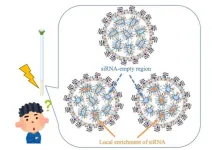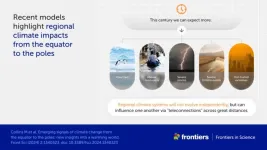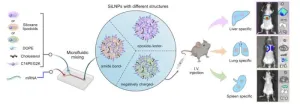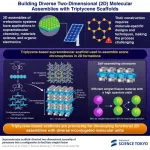(Press-News.org)
Small interfering RNA (siRNA) molecules hold immense potential for treating diseases by silencing specific genes. Encapsulated in lipid nanoparticles (LNPs), siRNA can be delivered efficiently to target cells. However, the effectiveness of these therapies hinges on the internal structure of the LNPs, which can significantly impact their ability to deliver siRNA. Traditional methods often fall short in providing the detailed molecular insights needed to fine-tune LNP design for optimal therapeutic efficacy.
A study published in the Journal of Controlled Release on August 02, 2024, led by Assistant Professor Keisuke Ueda from the Graduate School of Pharmaceutical Sciences, Chiba University, introduces a novel approach to improving siRNA-loaded LNPs. By employing NMR-based molecular-level characterization, the research investigates how different siRNA mixing methods affect the uniformity and molecular state of siRNA within LNPs. This research was coauthored by Dr. Hidetaka Akita from the Graduate School of Pharmaceutical Sciences, Tohoku University; Dr. Kenjirou Higashi from the Graduate School of Pharmaceutical Sciences, Chiba University; and Dr. Kunikazu Moribe (last author) from the Graduate School of Pharmaceutical Sciences, Chiba University.
“NMR allowed us to peer inside these nanoparticles at a molecular level, revealing the intricate details of how siRNA is distributed within the LNP core. This level of insight is crucial for understanding and optimizing LNP formulations," said Dr. Ueda.
The team compared three preparation methods for siRNA-loaded LNPs to understand their impact on molecular structure and gene-silencing efficiency. The methods included pre-mixing, where siRNA and lipids were combined using a microfluidic mixer; post-mixing (A), where siRNA was mixed with empty LNPs in an acidic condition with ethanol; and post-mixing (B), where siRNA was mixed with empty LNPs in an acidic condition without ethanol.
While all three methods produced LNPs with a consistent size of about 50nm and maintained a constant ratio of siRNA to lipid content, the distribution of siRNA within the LNPs varied significantly. The pre-mixing method, where siRNA and lipids are mixed simultaneously, resulted in a more uniform distribution of siRNA within the LNPs. In contrast, the post-mixing method, where siRNA is added to pre-formed LNPs, led to a heterogeneous distribution with regions of high and low siRNA concentration.
"This heterogeneity can significantly impact the silencing effect of the siRNA. LNPs with a more uniform siRNA distribution are more likely to deliver their therapeutic payload to target cells effectively. This highlights the critical need to optimize preparation conditions for improving therapeutic outcomes," explains Dr. Ueda.
The findings indicate that pre-mixed LNPs exhibit superior gene-silencing effects. In these LNPs, ionizable lipids were more tightly associated with siRNA, forming a stacked bilayer structure that enhanced gene silencing. In contrast, post-mixed LNPs displayed a more heterogeneous structure, likely impeding their ability to fuse with cell membranes and reducing their therapeutic effectiveness.
“This research could improve people's lives by enhancing gene therapies and RNA-based medicines. By optimizing how siRNA is delivered using lipid nanoparticles (LNPs), treatments for diseases like cancer, genetic disorders, and viral infections could become more effective. Additionally, it could improve the efficiency and safety of RNA vaccines, like those used for COVID-19, by making them more stable and reducing side effects. Overall, this study has the potential to lead to more effective and safer treatments for patients,” adds Dr. Ueda.
Looking ahead, these advancements could contribute to the development of more personalized medicine, with treatments tailored to individual patients. Enhanced drug delivery systems could also reduce costs and increase access to innovative therapies, benefiting a wider population.
About Assistant Professor Keisuke Ueda
Keisuke Ueda is an Assistant Professor at the Graduate School of Pharmaceutical Sciences, Chiba University. He is engaged in pharmaceutical formulation research, education, and collaborative research with the pharmaceutical industry. He received his Ph.D. in Pharmaceutical Sciences from Chiba University in 2015. He has contributed to more than 90 peer-reviewed publications and serves on the Editorial Advisory Board for Molecular Pharmaceutics (American Chemical Society). In 2021, one of his articles was selected as the ACS Editors’ Choice. In addition, one of his articles in 2022 was featured on the front cover of Volume 19, Issue 1, of Molecular Pharmaceutics.
END
Mount Sinai Health System’s Chief Executive Officer (CEO) and the Emergency Department Chair at Mount Sinai Queens have been recognized with top honors for their outstanding achievements at the American College of Emergency Physicians (ACEP) 2024 Scientific Assembly in Las Vegas during a special ceremony on Monday, September 30.
Brendan G. Carr, MD, MS, FACEP, CEO, Professor and Kenneth L. Davis, MD, Distinguished Chair of the Mount Sinai Health System, received the Colin C. Rorrie, Jr, PhD Award for Excellence in Health Policy.
This award is an extraordinary ...
PULLMAN, Wash. – To appeal to the majority of consumers, winemakers may want to pay as much attention to what’s on the bottle as what’s in it.
A three-part experimental study led by Washington State University researchers found that women were more inclined to purchase wine that had labels with feminine gender cues. The more strongly the participants identified with other women, a phenomenon called “in-group identification,” the greater this effect was. A feminine label also influenced their expectation that they would like the wine better.
With women representing 59% ...
The effects of climate change are not distant future scenarios or confined to remote parts of the world—they are unfolding now, right in our own backyards. In 2023, extreme weather events impacted communities across every inhabited continent, causing major flooding, droughts, and wildfires.
While worldwide changes, such as increases in global mean temperature, often dominate discussions of mitigation actions, a detailed understanding of the regional impacts of a warming world is crucial for protecting communities from escalating risks. A team of researchers writing in Frontiers in Science synthesized results ...
UCLA researchers have developed a deep-learning framework that teaches itself quickly to automatically analyze and diagnose MRIs and other 3D medical images – with accuracy matching that of medical specialists in a fraction of the time. An article describing the work and the system’s capabilities is published in Nature Biomedical Engineering.
Unlike the few other models being developed to analyze 3D images, the new framework has wide adaptability across a variety of imaging modalities. The developers have studied it with 3D retinal scans (optical coherence tomography) for disease ...
As many as 249 lives could have been saved in London during the 2018 record-setting hot summer had the city widely adopted cool roofs, estimates a new study by researchers at UCL and the University of Exeter.
The paper, published in Nature Cities, analysed the cooling effect that roofs painted white or other reflective colours would have on London’s ambient temperature between June and August 2018, the city’s hottest summer. From June through August, the average temperature around London was 19.2 degrees C, about ...
While divisive social media posts get more traction in countries such as the US, a new study shows that celebrating national unity is the way to go viral in Ukraine.
“Ingroup solidarity” statements got far more likes and shares than hostile posts about Russians – a trend that only grew stronger in the wake of the invasion.
The first major study of social media behaviour during wartime has found that posts celebrating national and cultural unity in a country under attack receive significantly more online engagement than derogatory posts about the aggressors.
University of Cambridge psychologists analysed a total of 1.6 million ...
UNDER STRICT EMBARGO UNTIL 10AM (UK TIME) ON TUESDAY 1 OCTOBER 2024.
Peer reviewed | Observational study | People
Research led by scientists at Queen Mary University of London is heralding in a new era for genetic sequencing and testing.
In the largest study of its kind to date, published today in Nature Medicine, an international group of researchers led by Queen Mary used new bioinformatics techniques to scan the genetic profiles of 80,000 people to understand the frequency of specific expansions of short repetitive DNA sequences in the general population.
These expansions are the most common cause of inherited neurological ...
Deep brain stimulation may provide immediate improvement in arm and hand strength and function weakened by traumatic brain injury or stroke, University of Pittsburgh School of Medicine researchers report today in Nature Communications.
Encouraging results from extensive tests in monkeys and humans open a path for a new clinical application of an already widely used brain stimulation technology and offer insights into neural mechanisms underlying movement deficits caused by brain injury.
“Arm and hand paralysis significantly impacts the quality ...
Penn Engineers have discovered a novel means of directing lipid nanoparticles (LNPs), the revolutionary molecules that delivered the COVID-19 vaccines, to target specific tissues, presaging a new era in personalized medicine and gene therapy.
While past research — including at Penn Engineering — has screened “libraries” of LNPs to find specific variants that target organs like the lungs, this approach is akin to trial and error. “We’ve never understood how the structure of one key component of the LNP, ...
Research in the field of material science and electronics relies on the innovative arrangement of molecules or atoms to develop materials with unique properties not found in conventional materials. Two-dimensional (2D) assemblies of π-electronic systems, arranged in thin layers, are becoming increasingly important in the fields of materials science and organic electronics. Their unique arrangement allows for specific electronic and physical properties, making them ideal for applications like solar cells, and flexible displays. However, creating such assemblies is challenging because it often requires special designs and techniques for each ...





